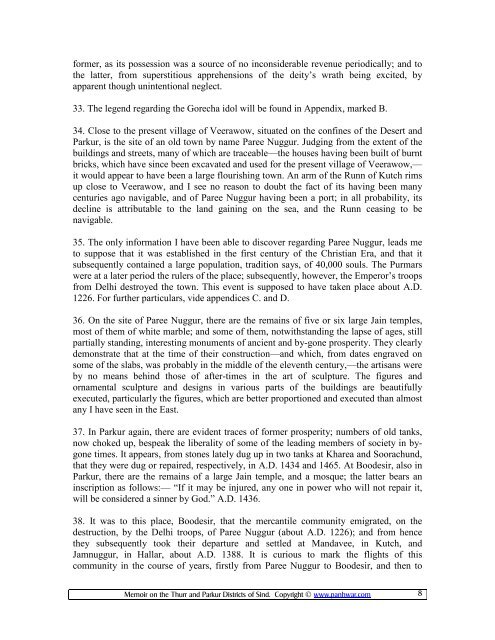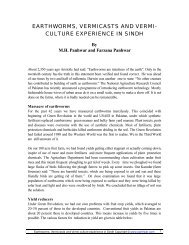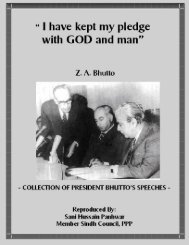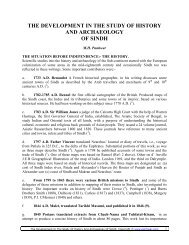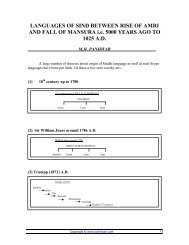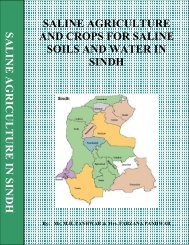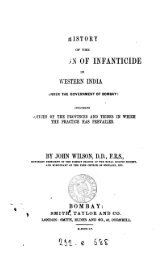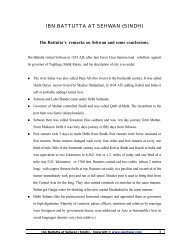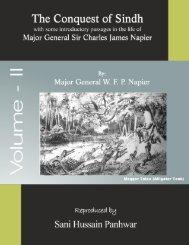Memoir on Thar and
Memoir on Thar and
Memoir on Thar and
You also want an ePaper? Increase the reach of your titles
YUMPU automatically turns print PDFs into web optimized ePapers that Google loves.
former, as its possessi<strong>on</strong> was a source of no inc<strong>on</strong>siderable revenue periodically; <strong>and</strong> to<br />
the latter, from superstitious apprehensi<strong>on</strong>s of the deity’s wrath being excited, by<br />
apparent though unintenti<strong>on</strong>al neglect.<br />
33. The legend regarding the Gorecha idol will be found in Appendix, marked B.<br />
34. Close to the present village of Veerawow, situated <strong>on</strong> the c<strong>on</strong>fines of the Desert <strong>and</strong><br />
Parkur, is the site of an old town by name Paree Nuggur. Judging from the extent of the<br />
buildings <strong>and</strong> streets, many of which are traceable—the houses having been built of burnt<br />
bricks, which have since been excavated <strong>and</strong> used for the present village of Veerawow,—<br />
it would appear to have been a large flourishing town. An arm of the Runn of Kutch rims<br />
up close to Veerawow, <strong>and</strong> I see no reas<strong>on</strong> to doubt the fact of its having been many<br />
centuries ago navigable, <strong>and</strong> of Paree Nuggur having been a port; in all probability, its<br />
decline is attributable to the l<strong>and</strong> gaining <strong>on</strong> the sea, <strong>and</strong> the Runn ceasing to be<br />
navigable.<br />
35. The <strong>on</strong>ly informati<strong>on</strong> I have been able to discover regarding Paree Nuggur, leads me<br />
to suppose that it was established in the first century of the Christian Era, <strong>and</strong> that it<br />
subsequently c<strong>on</strong>tained a large populati<strong>on</strong>, traditi<strong>on</strong> says, of 40,000 souls. The Purmars<br />
were at a later period the rulers of the place; subsequently, however, the Emperor’s troops<br />
from Delhi destroyed the town. This event is supposed to have taken place about A.D.<br />
1226. For further particulars, vide appendices C. <strong>and</strong> D.<br />
36. On the site of Paree Nuggur, there are the remains of five or six large Jain temples,<br />
most of them of white marble; <strong>and</strong> some of them, notwithst<strong>and</strong>ing the lapse of ages, still<br />
partially st<strong>and</strong>ing, interesting m<strong>on</strong>uments of ancient <strong>and</strong> by-g<strong>on</strong>e prosperity. They clearly<br />
dem<strong>on</strong>strate that at the time of their c<strong>on</strong>structi<strong>on</strong>—<strong>and</strong> which, from dates engraved <strong>on</strong><br />
some of the slabs, was probably in the middle of the eleventh century,—the artisans were<br />
by no means behind those of after-times in the art of sculpture. The figures <strong>and</strong><br />
ornamental sculpture <strong>and</strong> designs in various parts of the buildings are beautifully<br />
executed, particularly the figures, which are better proporti<strong>on</strong>ed <strong>and</strong> executed than almost<br />
any I have seen in the East.<br />
37. In Parkur again, there are evident traces of former prosperity; numbers of old tanks,<br />
now choked up, bespeak the liberality of some of the leading members of society in byg<strong>on</strong>e<br />
times. It appears, from st<strong>on</strong>es lately dug up in two tanks at Kharea <strong>and</strong> Soorachund,<br />
that they were dug or repaired, respectively, in A.D. 1434 <strong>and</strong> 1465. At Boodesir, also in<br />
Parkur, there are the remains of a large Jain temple, <strong>and</strong> a mosque; the latter bears an<br />
inscripti<strong>on</strong> as follows:— “If it may be injured, any <strong>on</strong>e in power who will not repair it,<br />
will be c<strong>on</strong>sidered a sinner by God.” A.D. 1436.<br />
38. It was to this place, Boodesir, that the mercantile community emigrated, <strong>on</strong> the<br />
destructi<strong>on</strong>, by the Delhi troops, of Paree Nuggur (about A.D. 1226); <strong>and</strong> from hence<br />
they subsequently took their departure <strong>and</strong> settled at M<strong>and</strong>avee, in Kutch, <strong>and</strong><br />
Jamnuggur, in Hallar, about A.D. 1388. It is curious to mark the flights of this<br />
community in the course of years, firstly from Paree Nuggur to Boodesir, <strong>and</strong> then to<br />
<str<strong>on</strong>g>Memoir</str<strong>on</strong>g> <strong>on</strong> the Thurr <strong>and</strong> Parkur Districts of Sind. Copyright © www.panhwar.com<br />
8


